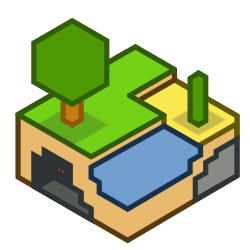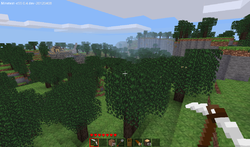This article may be too technical for most readers to understand. (June 2024) |
| Luanti | |
|---|---|
 | |
 | |
| Original author | Perttu Ahola |
| Developer | The Luanti Team |
| Initial release | 0.0.1 / 2 November 2010 |
| Stable release | 5.13.0[1] |
| Repository | github |
| Written in | C++, Lua |
| Engine | Irrlicht (Irrlicht-MT fork) |
| Platform | Microsoft Windows, MacOS, Linux, FreeBSD, Android |
| Type | Sandbox |
| License | 2013: LGPL-2.1-or-later[2][3] 2010: GPL-2.0-or-later[4][5] Original: Proprietary[6] |
| Website | www |
Luanti (also known by its former name Minetest) is a community-driven, free and open-source scripting voxel game engine based on Irrlitcht Engine, and is available on various mobile and desktop devices, including GNU variants, and BSD descendants. Originally, Luanti was a voxel game created in October 2010 by Perttu Ahola (recognized as celeron55 or c55) to explore the mechanics of Minecraft.[1] Over time, Luanti has evolved from the original Minetest game into a general game engine as developers have actively integrated new features.
Luanti's scripting system is organized into games and modules (commonly called "mods"). A game is a collection of mods that define the major content and overall behavior, while individual mods are Lua scripts that add or modify specific features. The community considers Luanti a game engine rather than a singular game, as it offers no playable content by itself.
Luanti also integrates a built-in browser which allows users to download games and mods from the external ContentDB website.[7] The five most popular games by downloads are VoxeLibre, Minetest Game, Mineclonia, Backrooms Test, and NodeCore.[8]
In October 2024, the project’s name was officially changed from Minetest to Luanti. The new name combines Lua (the scripting language) with the Finnish word luonti, meaning "creation".[9]

Games are playable through worlds that are assembled by fixed 3D voxels aligned in a fixed position called nodes, which could allow modders (alias for developers) to create unique scenery that may be represented by various types of nodes, such as blocks and waters. Conversely, objects or entities are commonly used to create a variety of animated creatures called mobs (or mobiles) that have an ability to walk, crawl, fly, and so on.
VoxeLibre is the primary example of a game which consists of real-world biomes with a variety of mobs that can spawn. It also has numerous game mechanics which allow for countless objectives such as building houses, farming, smelting, cooking, and so on.
On the other hand, Minetest Game (abbreviated to MTG) was designed without mobs or a clear game objective, since it was designed to be a modding base with sets of nodes and pre-generated biomes.

As players explore the world, new areas are procedurally generated using a map seed optionally specified by the player. A new game puts the player in the center of a map 62 thousand nodes across, so the player can travel 31 thousand nodes in any direction (sideways, up, or down)[10] before reaching the invisible wall at the end of the world.
The world is divided into biomes ranging from deserts to jungles to snowfields; the terrain can include plains, mountains, forests, caves, water, or even lava, depending on the game and mod installed. The in-game time system follows a day and night cycle, with one full cycle lasting 20 real-time minutes by default.
Luanti provides two play-style options across games: Enable Damage and Creative Mode. Disabling damage prevents dying, thus losing items and the possible frustration it might cause, while Creative Mode provides players with infinite resources to build whatever they want without having to gather them first.[11]

Luanti allows players to play together over the internet or the local network by joining a server or hosting their own.
Players can either connect by IP or select the server from the built-in server browser if the host chooses to publish it there by selecting the checkbox.
Rather than the centralized account systems typically used by proprietary games across multiple game servers, Luanti allows registering and logging into accounts on each individual server, thereby allowing players to have multiple different accounts on each server, entirely separate from each other.

Luanti provides an interface for games and mods written in Lua. Mods are server-side and work out of the box when playing on servers, with no installation required.
Luanti features a built-in content browser showing packages uploaded to ContentDB, allowing users to install games, mods and texture packs with a single click. Over 2500 packages are available there as of October 2024[12] and many more on the forums.

Mods can be used to add or modify nodes, gameplay mechanics, tools, weapons, armour, monsters, player skins and the user interface.
The full source code of Luanti and most of its games and their artistic assets such as textures and sounds, are distributed under free licenses, making it easier to publish modified versions and derivatives.

Luanti was originally released in November 2010 under a proprietary license.[6] Shortly afterwards the license was changed to the GPL-2.0-or-later license.[5] By agreement among major contributors, in June 2012 the project license was to be changed to LGPL-2.1-or-later, though at the time small parts still remained under the GPL-2.0-or-later license.[4] In September 2013, the transition was complete.[3] While LGPL-2.1-or-later remains the main license for the Luanti engine, other free and open-source licenses are used for various other parts of the latest release.[2]
Perttu Ahola was the only developer working on the project for about six months, until Ciaran Gultnieks started making code contributions in May 2011.[13] The roster of contributors grew and changed over the years. As of July 2020, there are 9 active core developers and 15 active contributors. Project participants do not have set roles, but rather keep their activity within their respective areas of expertise. Perttu Ahola's role morphed over the years: whereas initially it was engine development, it is now mostly web-hosting and administration, assigning core developer, moderator, and other roles to people, as well as being the final word in cases where other developers are unable to render a decision.[13]
Since version 5.0.0 the in-game browser lets users download games and modifications as well as their dependencies from a website called ContentDB and the Irrlicht Engine was forked.[14]
As of version 5.8.0 the Luanti Engine no longer ships with a default game.[15]
Luanti has been used in educational environments to teach subjects such as mathematics, programming, and earth sciences. Such examples are:
Opensource.com listed Luanti at #1 in its "Best open source games of 2015",[19] stating that it is maybe "the most complete alternative to Minecraft", and noted its expansibility, saying that it contains a user-friendly API for creating mods in Lua.[20] PC Magazine listed Luanti among "The best Sandbox Creation Games for Minecraft Fans".[21]
CDB has 2526 packages, with a total of 14871145 downloads.
{{cite journal}}: CS1 maint: multiple names: authors list (link)